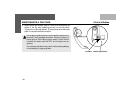
111
MAINTENANCE & CAR CARE Battery
Connect leads in the order as shown in the sketch :
• Do not connect the lead to the negative terminal of the
discharged battery.
• The connection of the -ve lead point should be as far
away from the discharged battery as possible and close
to the starter motor on engine/transaxle.
• Route the leads so that they cannot get caught by the
rotating parts in the engine compartment.
• The engine of the car providing the jump start can be
allowed to run during starting.
Attempts to start the engine of the car with the discharged
battery should be made at intervals of one minute and should
not last more than 15 seconds. After starting, allow both
engines to idle for approximately 3 minutes with the leads
still connected.
Starting the Engine with Jump Leads :
The engine with a discharged battery may be started by
transferring electrical power from a battery in another car.
This may be dangerous as any deviation from the following
instructions could lead to personal injury resulting from any
battery explosion, as well as damage to the electrical
systems in both cars.
Do not allow battery electrolyte to come in contact
with eyes, skin, fabrics or painted surfaces. The fluid
contains sulphuric acid which can cause injury and
severe damage. Wear rubber gloves, to avoid risk of
contact.
• To lessen the risk of injury, wear eye protection when
working near any battery.
• Make sure that the battery providing the jump start has the
same voltage as the battery in your car (12 V). Its capacity
must be approximately the same as the original battery
capacity. The voltage and capacity are given on the batteries.
• Do not disconnect the discharged battery from the car.
• Switch off all unnecessary electrical loads.
• Do not lean over the battery during jump starting.
• Do not allow the terminals of one lead to touch those of
the other lead.
• Apply the hand brake. Keep the gearshift lever in neutral.


















